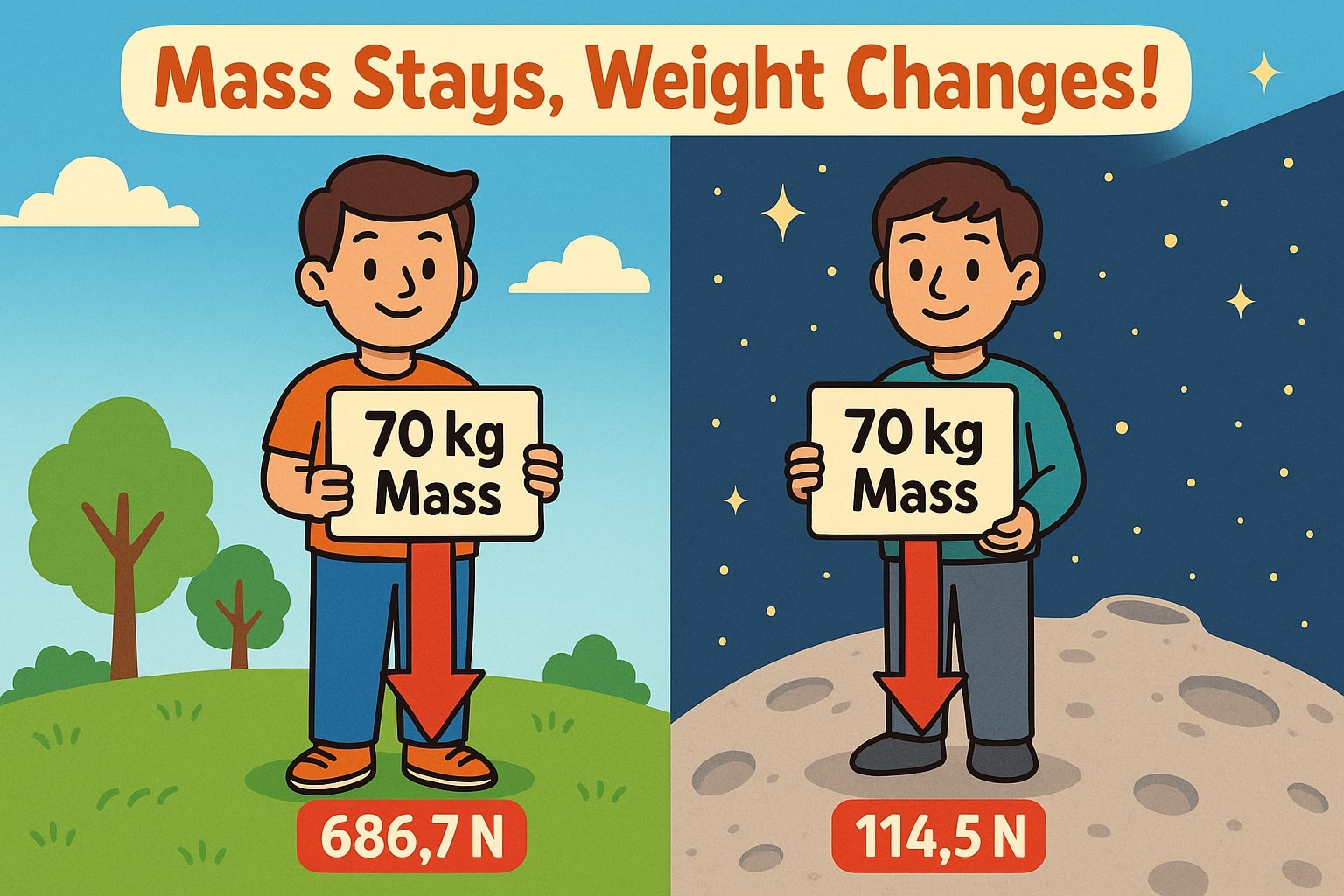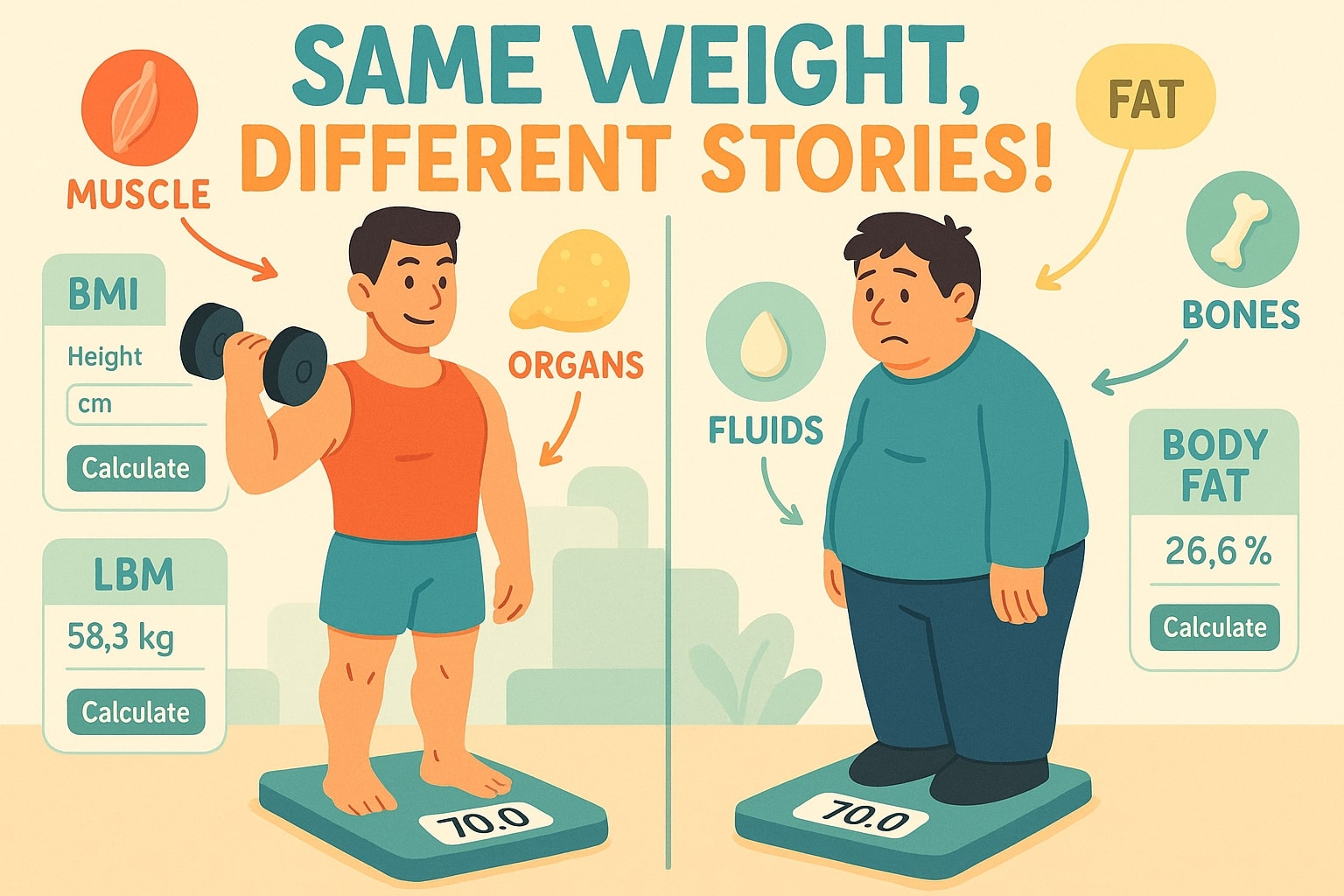Weight plays a constant role in our lives—appearing on food labels, gym machines, flight check-ins, and medical charts. Yet despite how common it is, we often overlook its full significance.
Maybe you’re here to convert pounds to kilograms or find a quick answer using a weight conversion chart. But there's more to weight than simple numbers. It’s a concept rooted in physics, applied in health, and shaped by the force of gravity. Whether you're exploring it for curiosity or necessity, this guide will help you understand why weight matters on a scientific, personal, and practical level.
What Is Weight?
In everyday conversations, we often use “weight” and “mass” interchangeably, assuming they mean the same thing. Take the phrase “I weigh 70 kilograms” — it sounds normal, but it’s not scientifically accurate. What we actually mean is “my mass is 70 kilograms.” Despite their similar use in casual speech, these terms have very different meanings in science.
Mass measures the amount of matter an object contains. It’s expressed in kilograms (kg) and remains constant no matter where the object is — whether on Earth, Mars, or drifting in outer space¹.
Weight, by contrast, is a force — specifically, the gravitational force pulling on that mass. It’s calculated using this formula:
Weight (W) = Mass (m) × Gravitational acceleration (g)
On Earth, gravitational acceleration is roughly 9.81 meters per second squared (m/s²). So someone with a mass of 70 kg would have a weight of about 686.7 newtons (N) — not 70 kilograms².

This difference becomes obvious in different gravitational environments. On the Moon, gravity is around one-sixth as strong as Earth’s. That same individual would still have a mass of 70 kg, but their weight would drop to about 114.5 N. That’s why astronauts appear to float or bounce — their mass hasn’t changed, but their weight certainly has³.
In technical fields such as physics, engineering, medicine, and aerospace, distinguishing between mass and weight is vital. Confusing the two can lead to serious mistakes — as demonstrated by the infamous error in NASA’s Mars Climate Orbiter mission⁴.
What Would You Weigh on Mars? A Cosmic Perspective on Weight
If you’ve ever been curious about how much you’d weigh on another planet, you’re definitely not alone. It’s one of the most intriguing questions people ask after discovering that weight depends on gravity. While your mass stays constant no matter where you travel, your weight can vary significantly depending on the gravitational force of the planet beneath your feet.
Take Mars, for instance — often nicknamed Earth’s little brother. Gravity on Mars is roughly 38% of Earth’s gravity. So, if you tip the scale at 150 pounds on Earth, you’d weigh only about 57 pounds on Mars. Same body, same muscles, same everything — just a lighter gravitational pull acting on you.
|
Planet |
Gravity (m/s²) |
% of Earth Gravity |
Weight (Earth = 150 lb) |
|
Earth |
9.81 |
100% |
150 lb |
|
Moon |
1.62 |
16.5% |
~25 lb |
|
Mars |
3.71 |
38% |
~57 lb |
|
Jupiter |
24.79 |
252% |
~378 lb |
|
Pluto |
0.62 |
6.3% |
~9.5 lb |
This isn’t just a neat party fact (though it definitely qualifies as one). Space agencies rely on these exact calculations when building equipment, spacesuits, and specialized tools. Think about it — try walking around in Earth-weighted gear on Jupiter, and you probably wouldn’t get past your first step.
Your body stays the same, but the environment doesn’t. That’s the beauty of weight — it’s a context-based measurement that shows how your mass interacts with gravity wherever you are. Sure, a weight converter on Earth can help you flip between pounds and kilograms, but a space weight calculator? That reveals just how much the cosmos can change your experience.
💡 Want to feel lighter instantly — no workouts or diets required? Just hop aboard a spaceship to the Moon⁵
Weight in the Human Body
When you step on a scale and see a number, what is it actually telling you?
At first glance, the answer seems obvious — you're measuring your weight. But look closer, and you’ll realize that number represents more than just your presence on Earth. It reflects the total of everything your body consists of: muscle, fat, bones, organs, fluids, and even your most recent meal. That value is the gravitational force acting on your body mass, but biologically, it’s far more complex.
Health professionals understand this, which is why body weight is just a starting point, not the full picture. A fit athlete and a person with a sedentary lifestyle might weigh the same, yet their body composition and overall health could be drastically different. That’s where tools like BMI calculator, Body Fat Percentage Calculator, and Lean Body Mass (LBM) Calculator become vital — they give that number real-world meaning⁶.
For example, someone with a “normal” BMI could still have high levels of visceral fat — the dangerous kind that wraps around organs and increases the risk of heart disease, diabetes, and inflammation⁷. Meanwhile, a heavier-than-average weight might be totally healthy for someone with a high muscle-to-fat ratio. The scale doesn’t always tell the full story — but you should know the difference.
Weight also plays a critical role in medicine. Medication dosages — particularly for children, anesthesia, or chemotherapy — are often tailored based on body weight. In hospitals, even a minor miscalculation can result in improper treatment protocols⁸. That’s why getting an accurate measurement and understanding what it reflects is a matter of precision, not appearance.

Weight Conversion Chart (For Everyday Use)
Sometimes, you just need a fast and dependable way to convert weight — whether you're cooking a recipe, planning a trip, studying, or trying to decode product labels from another country. That’s where a well-structured weight conversion chart becomes incredibly useful. No need for mental math. No room for error. Just simple, accurate conversions between the most common weight units.
The table below provides easy-to-read conversions between kilograms, grams, pounds, ounces, and stones — covering both metric and imperial systems. It’s an ideal reference tool for everything from daily tasks to academic needs, and it's especially helpful for students, travelers, and professionals alike.
| Unit (Symbol) | Equivalent to 1 Kilogram |
|---|---|
| Metric Tonne (t) | 0.001 t |
| Kilogram (kg) | 1 kg |
| Hectogram (hg) | 10 hg |
| Dekagram (dag) | 100 dag |
| Gram (g) | 1,000 g |
| Decigram (dg) | 10,000 dg |
| Centigram (cg) | 100,000 cg |
| Milligram (mg) | 1,000,000 mg |
| Microgram (µg) | 1,000,000,000 µg |
| Nanogram (ng) | 1,000,000,000,000 ng |
US Customary & Imperial Units
| Unit (Symbol) | Equivalent to 1 Kilogram |
|---|---|
| Ounce (oz) | 35.27396 oz |
| Pound (lb) | 2.20462 lb |
| Stone (st) | 0.15747 st |
| Hundredweight (US) (cwt US) | 0.02205 cwt |
| Hundredweight (UK) (cwt UK) | 0.01968 cwt |
| Ton (US) (ton US) | 0.001102 ton |
| Ton (UK) (ton UK) | 0.0009842 ton |
Scientific & Specialized Units
| Unit (Symbol) | Equivalent to 1 Kilogram |
|---|---|
| Slug (slug) | 0.06852 slug |
| Planck Mass (mₚ) | 4.59 × 10⁷ mₚ |
| Atomic Mass Unit (u) | 6.022 × 10²⁶ u |
| Carat (ct) | 5,000 ct |
| Grain (gr) | 15,432.36 gr |
Check out Conversion section for more automatic, fast and easy conversion tools.
When Gravity Took Center Stage on the Moon
One of the most memorable physics experiments didn’t take place in a lab or classroom — it happened on the Moon.
In 1971, during the Apollo 15 mission, astronaut David Scott performed a brilliantly simple experiment. Standing on the lunar surface, he held a hammer in one hand and a feather in the other — then dropped them at the same time. Unlike Earth, where air resistance slows down lighter objects, the Moon has no atmosphere. So both the hammer and feather landed together, hitting the surface simultaneously⁹.
The moment was both visually powerful and scientifically profound. It confirmed a truth that still surprises many: in a vacuum, everything falls at the same rate, no matter the mass. Gravity acts equally on all objects when air isn’t part of the equation. On Earth, we often blur the line between mass and weight, but this Moon experiment made the distinction crystal clear — weight is just mass influenced by gravity. Change the gravitational force, and the weight shifts, but the mass stays constant.
It was physics brought to life — in space — and it reshaped how we understand what weight really means.
¹ National Institute of Standards and Technology (NIST). Mass and Weight.
² NASA Glenn Research Center. Weight vs. Mass.
³ NASA. Gravity on the Moon.
⁴ NASA. Metric Confusion Contributed to Mars Climate Orbiter Loss.
⁵ NASA. Mars Fact Sheet.
⁶ National Institute of Diabetes and Digestive and Kidney Diseases (NIDDK). Health Risks of Being Overweight.
⁷ Mayo Clinic. The Truth About Belly Fat: How Visceral Fat Affects Your Health.
⁸ Centers for Disease Control and Prevention (CDC). Measuring Weight Accurately.
⁹ NASA. The Apollo 15 Hammer-Feather Drop.
Here are some popular tools you might want to look up:

